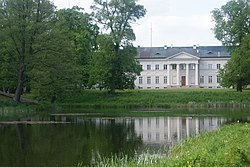
The Battle of Warsaw, also known as the Miracle on the Vistula, was a series of battles that resulted in a decisive Polish victory and complete disintegration of the Red Army in August 1920 during the Polish–Soviet War.

Suraż is a town in north-eastern Poland situated in the Podlaskie Voivodeship, seat of Gmina Suraż in the Białystok County.

The Wieprz is a river in central-eastern Poland, and a tributary of the Vistula. It is the country's ninth longest river, with a total length of 349 km and a catchment area of 10,497 km2, all within Poland. Its course near the town of Łęczna includes the protected area known as Wieprz Landscape Park.

The Battle of Kock was the final battle in the invasion of Poland at the beginning of World War II in Europe. It took place between 2–5 October 1939, near the town of Kock, in Poland.

Góra Kalwaria is a town on the Vistula River in the Masovian Voivodeship, in east-central Poland. It is situated approximately 35 kilometres southeast of Warsaw and has a population of around 12,109. The town has strong religious significance for both Catholic Christians and Hasidic Jews of the Ger dynasty.
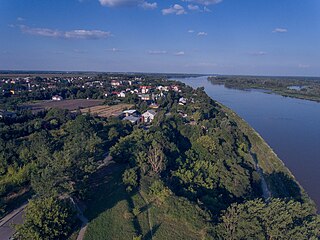
Wyszogród is a town in central Poland, in Masovian Voivodeship, in Płock County, by the Vistula River. The population of Wyszogród was 2,793 in 2004.
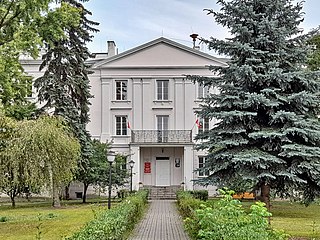
Radzymin is a town in Poland and is one of the distant suburbs of the city of Warsaw. It is located in the powiat of Wołomin of the Masovian Voivodeship. The town has 8,818 inhabitants.
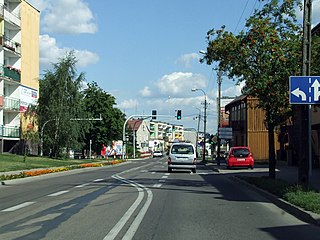
Żuromin is a town in north-central Poland, in Masovian Voivodeship, about 120 kilometres northwest of Warsaw. It is the capital of Żuromin County.
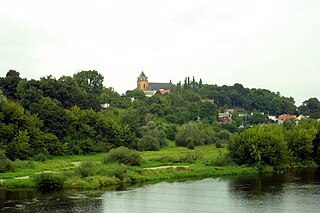
Różan is a town in Mazovian Voivodeship, northeastern Poland, on the river Narew. National roads 60 and 61 intersect in the town.

Kałuszyn is a town in Poland, seat of the Gmina Kałuszyn (commune) in Mińsk County in Masovian Voivodeship.

Sulejówek is a town in Poland, about 18 km east of Warsaw city centre and part of its metropolitan area. It is located in Masovian Voivodeship, in Mińsk County. Its population numbers 19323 (2011).

Sędziszów is a town in Jędrzejów County, Świętokrzyskie Voivodeship, Poland, with 6,830 inhabitants (2004). The town belongs to Lesser Poland.
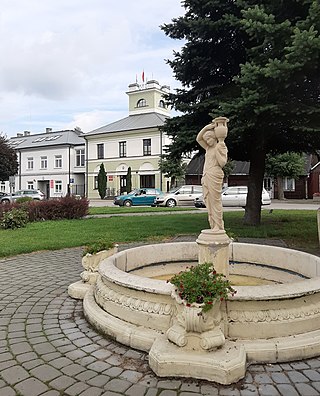
Mogielnica is a town in Grójec County in Masovian Voivodeship, Poland, with 2,475 inhabitants (2004) and an area of 141.56 square kilometres. It is the seat of Gmina Mogielnica.
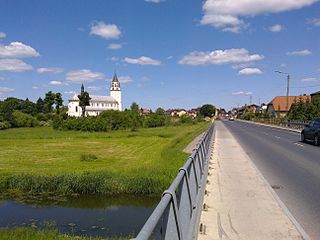
Chorzele is a town in Przasnysz County, Masovian Voivodeship, Poland, on the Orzyc River.

Łaskarzew is a town in Garwolin County, Masovian Voivodeship, Poland, with 4,948 inhabitants (2004). It is located on the Promnik river, which is a tributary of the Vistula, near the Garwolin Forests, on the border of historic Polish provinces of Lesser Poland and Mazovia.

Golina is a town in Konin County, Greater Poland Voivodeship, in central Poland, with 4,398 inhabitants (2010). It is located 12 km (7.5 mi) west from Konin.

Ślesin is a town in Konin County, Greater Poland Voivodeship, in central Poland, with 3,200 inhabitants (2010).
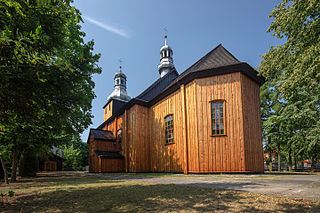
Węglewice is a village in the administrative district of Gmina Galewice, within Wieruszów County, Łódź Voivodeship, in central Poland. It lies approximately 7 kilometres (4 mi) north-west of Galewice, 12 km (7 mi) north-east of Wieruszów, and 97 km (60 mi) south-west of the regional capital Łódź.
Bobrowniki is a village in the administrative district of Gmina Ryki, within Ryki County, Lublin Voivodeship, in eastern Poland. It lies in northeastern corner of historic Lesser Poland, approximately 10 kilometres (6 mi) south of Ryki and 56 km (35 mi) north-west of the regional capital Lublin. The village was officially a town from 1485 to 1869.
Polish 60th Infantry Division was an infantry division of the Polish Army, which fought in the September 1939 Invasion of Poland. This unit, which was first named Division Kobryn, was not part of peacetime organization of the army, and was created in mid-September 1939, out of reserve units of Military District IX. It was formed in the town of Kobryn, and guns and ammunition for the division were delivered by Warsaw city buses, from Central Ammunition Depot Nr 2 in Stawy near Dęblin. The division was commanded by Colonel Adam Epler.
